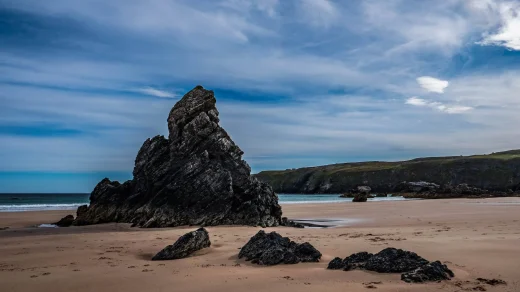This list of Inner Hebrides summarises a chain of islands and skerries located off the west coast of mainland Scotland. There are 36 inhabited islands in this archipelago, of which Islay, Mull and Skye are the largest and most populous.
The islands of Scotland’s west coast are known collectively as the Hebrides; the Inner Hebrides are separated from the Outer Hebrides by The Minch to the north and the Sea of the Hebrides to the south. The Inner Hebrides that lie respectively north and south of Ardnamurchan are administered by two separate local authorities as part of larger territories. The northern Inner Hebrides, including Skye, the Small Isles and the Summer Isles, are part of the Highland unitary council region. The southern group, including Islay, Jura, the Slate Islands and Gigha are part of the Argyll and Bute council region.
In the past, the Hebrides as a whole were a strong Scottish Gaelic-speaking area, and in 1921 more than 50% of the populations of most of these islands, including Skye, Mull and Islay, were proficient in the language. However, although the Outer Hebrides have retained many Gaelic speakers, in the 2001 census only Skye (31%) and Tiree (48%) had more than 25% of the resident population able to speak Gaelic; Mull, Jura, Gigha and Coll each recorded figures of less than 15%.
The modern economy centres on tourism, crofting, farming, fishing, and whisky distilling. The archipelago is exposed to wind and tide. There are numerous lighthouses as an aid to navigation.
There are various descriptions of the scope of the Hebrides. The Collins Encyclopedia of Scotland describes the Inner Hebrides as lying “east of The Minch”, which would include any and all offshore islands. There are various islands that lie in the sea lochs, such as Eilean Bàn and Eilean Donan, that might not ordinarily be described as “Hebridean”, but no formal definition exists and for simplicity they are included in this list rather than elsewhere.
Etymology.

Various Gaelic names are used repeatedly. The suffix ay or aigh or aidh is generally from the Norse øy meaning “island”. Eilean (plural: eileanan) also means “island”. Beag and mòr (also bheag and mhòr) mean “little” and “big” and are often found together. Sgeir is “skerry” and often refers to a rock or rocks that lie submerged at high tide. Dubh is “black”, dearg is “red” and glas means “grey” or “green”. Orasaigh is from the Norse Örfirirsey meaning “tidal” or “ebb island”.
Inhabited islands.
The Clachan Bridge, Seil, also known as the “Bridge Over the Atlantic

Eilean Donan castle.

The Bullough mausoleum with the Rùm Cullin in the distance.

A restored traditional house on Tiree.

Bowmore, Islay with its distinctive round church.

Tobermory harbour, Mull.

The inhabited islands of the Inner Hebrides had a population of 18,257 in 2001, and 18,948 at the time of the 2011 census. The highest peaks of the islands have names deriving from both Gaelic and Old Norse, indicating the historical importance of these two cultures. The archaeological record for the period of Viking domination during the Early Historic period is, however, limited.
In the Outer Hebrides all of the inhabited islands are now connected to at least one other island by a land transport route, but only four Inner Hebridean islands are connected by road, all to the mainland. The Clachan Bridge from Argyll to Seil was designed by Thomas Telford and dates from 1792. Skye has been connected to Kyle of Lochalsh by the Skye Bridge since 1995. Danna is also connected to the Tayvallich peninsula in Argyll by a stone causeway; and tiny Eilean Donan, dominated by its castle, has had a connection to the mainland perhaps from as early as the 13th century. The arched bridge in use today was constructed in the early 20th century.




Great share!
many thanks x